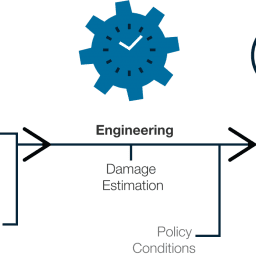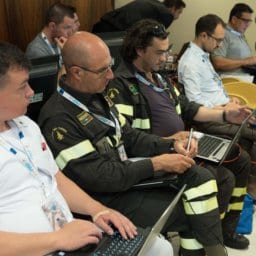“When managers and designers have done their jobs well, their interfaces generate positive feelings of success, competence, and mastery among users.” Schneiderman [1]
The IN-PREP project is designing and implementing a training system for civil protection and first responder agencies. In developing the IN-PREP system, the experience from crisis managers and civil protection practitioners has been harnessed. Their insights and feedback is being used in the system development of the IN-PREP training system and Mixed Reality Preparedness Platform (MRPP), a novel IT based training platform.
In the context of preparing, designing and implementing a large technical system such as the MRPP, it is important that the capabilities and limitations exhibited by users of technological systems, and how they come to bear on system development, are taken into consideration. Such aspects can be derived from a range of user needs that were gathered through literature research, interviews, and workshops within the first six months of the IN-PREP project.
A variety of differences exhibited by practitioners, pose challenges to system design processes such as:
- diversity in backgrounds,
- experience, and
- work styles
Therefore inclusion of the prospective users in the development of the system can help to facilitate acceptance and use of the system. Such participatory design processes can moreover help to ensure that the system is functional and fit for purpose, i.e. specifically customised.
Recommendations for system design include the following:
- Data management, sorting and storing, information transfer
Some practitioners highlight the challenge of acquiring relevant information, i.e. concrete and accurate information in real time in crisis situations. Particularly in view of the importance of actionable information and the correlation and interdependence between data and time in the context of professional crisis management, features that enable efficient data management thus represent an important system requirement. Considering the speed with which data can be transferred and the quantity of data that can be transmitted technologically, the tasks of sorting, evaluating, and communicating incoming and outgoing data are of great significance. Therefore, system features that permit sorting and storing of incoming and outgoing data sets, as well as features that enable quick information transfer are deemed essential.
- Pre-entered data, checklists and control lists
In the context of the challenge of handling large quantities of data features that allow for prior insertion of sets of data and the inclusion of checklists are also seen as useful by practitioners as pre-entered data and control lists that can be consulted can aid memory and recall as well as work performance. As such pre-entered data and control lists can be seen to help relieve work load pressures.
- Tracking data and recall of information
Logging features in which data and decisions can be archived enable the tracking of information and thus are likewise considered to constitute useful system features that can help to preclude the loss of information. Assisting the tracking of data and the recall of information, such system features can aid information management and help system operators to stay on top of information flows when a multitude of messages and data are received simultaneously.
- Facilitating exchange and interaction between different agencies
Practitioners note that a lack of collaboration represents particular challenges to successful crisis management. An absence of exchange and interaction can pose serious challenges to communication flows amongst different agencies in the context of collaborative team work. In order to facilitate collaboration, such as in terms of information exchange that leads to joint and coordinated responses, the implementation of features that generate awareness and knowledge with regard to agencies’ structural organisation, roles and responsibilities as well as an overview over their resources is therefore seen as useful.
- Consistency in system design
As disparities among information systems – or within them – can be seen to constitute a factor that can reduce overall efficiency of a system, practitioners prefer systems that are characterized by consistency in design. A multitude of e.g. different interfaces, terminologies, or access authorization procedures should therefore be avoided in system design.
- Design that aids decision makers through visualization
Practitioners note that in practice, technologies are generally utilized to aid work processes, rather than employed or expected to assume decision making capabilities. Whilst systems and their features can thus be seen to be used to enhance and support work processes, they cannot relieve system operators of the task of decision making. As decision making at its core revolves around risk assessment and probability calculations, system design that incorporates features that enable visualization and inspection of such data is considered beneficial.
- System functionality and usefulness
Whilst practitioners appear to prefer systems that offer characteristics such as:
- organized menus
- intelligible display design and
- logical arrangement of system features on display screens,
usefulness and performance of the system are considered to be more significant and valuable, i.e. of greater consequence. It is in this context that the aesthetics of a system are considered by some practitioners to be less important than the system’s functionality.
- Collective usability and ease of use
Due to the different responsibilities of the various organisations involved in crisis management and the distinctive sets of tasks to be undertaken, collective usability of the system and its features represents an important user requirement. With respect to a system’s features in the context of usability, practitioners note their preference for designs that enable intuitive use and quick familiarization. Ideally no or minimal training should be necessary prior to use and the system ought to be largely self-explanatory and easy to use.
- Clarity of the system’s purpose, functions and benefits
Noting the potential of technologies to be incredibly complex, the practitioners also favour designs that clearly indicate a system’s use, as it is when there exists clarity about the purpose, functions and benefits of a system, that the chances of the system being employed are increased.
In view of these recommendations, it becomes apparent that system design represents a process of convergence and development. It generally can be seen to not only involve research and preparation, but also testing (both usability and acceptance), maintenance, continuous evaluation and improvement.[2] Notably, the diverse stages of system design are not necessarily sequential but rather interdependent, recursive and dynamic, and may affect or be affected by one another.[3] Therefore, these processes ought to occur repeatedly and consistently, making use of on-going feedback loops to improve the system’s performance and quality.
Further information on these matters can be found on the download section of the IN-PREP website:
[1] Shneidermann et al., Designing the User Interface, Sixth Edition, Pearson, Harlow, 2018, p.33
[2] Shneidermann et al., Designing the User Interface, Sixth Edition, Pearson, Harlow, 2018, p.34
[3] Dul et al., A strategy for human factors/ergonomics: developing the discipline and profession, Ergonomics, 2012, p. 379
This blog on Crisis Managers’ recommendations for IN-PREP system development is by Dr. Pia Nottebaum (DHPol) and Larissa Müller (FhG).
Dr. Pia Nottebaum is a researcher in the Police Crisis Management unit at the German Police University (DHPol). She is a political scientist with a background in international relations, conflict, and security studies. The unit’s focus lies on police operational training in the context of crisis and disaster management, civil protection and cooperation and collaboration with other rescue and emergency services. The DHPol supports the IN-PREP exercises and demonstrations with a specific focus on the definition of the evaluation protocol and key performance indicators (KPIs). They support the end users/stakeholder recruitment process and the collection of end user requirements and contribute to the final IN-PREP evaluation and the Crisis Management Handbook.
Larissa Müller, M.A., is a researcher at Fraunhofer INT, in the business unit for (Public) Technology- and Innovation planning. She has a background in political science and sociology. Fraunhofer INT provides scientifically sound assessments and counseling on the entire spectrum of technological developments. On this basis, the Institute conducts Technology Forecasting, making possible a long-term approach to strategic research planning. Fraunhofer INT contributes to the identification of User Needs and Ethical, Legal and Human Factors in System Development. They lead the development of the Crisis Management Handbook and the identification of key performance indicators (KPIs) in transboundary crisis management.
Further reading/
Dul, Jan; Bruder, Ralph; Buckle, Peter; Carayon, Pascale; Falzon, Pierre; Marras, William S. et al. (2012): A strategy for human factors/ergonomics. Developing the discipline and profession. In Ergonomics 55 (4), pp. 377–395
Shneiderman, Ben, Plaisant, Catherine, Cohen, Maxine; Jacobs, Steven; Elmqvist, Niklas; Diakopolous, Nicholas (2018): Designing the user interface. Strategies for effective human-computer interaction. 6th ed. Pearson: Harlow.









